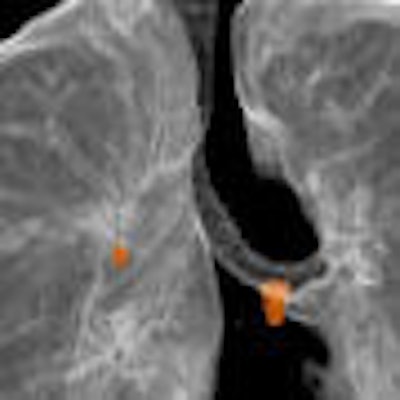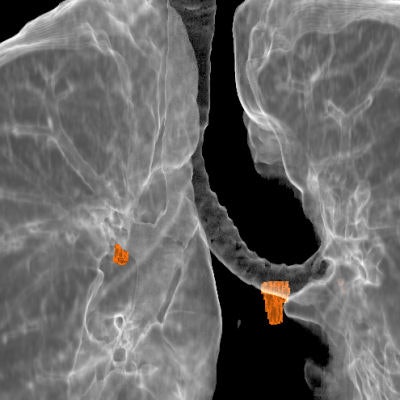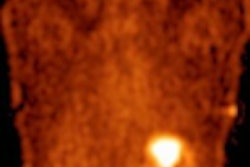
TORONTO - A 3D volumetric virtual bronchoscopy rendering was named the 2005 Image of the Year at the Society of Nuclear Medicine (SNM) meeting on Monday. The Stanford University study was designed to validate a PET/CT acquisition and image processing protocol to produce 3D rendered fusion images.
The image was part of the study, "Novel 3-D Rendered FDG-PET/CT Virtual Bronchoscopy and Colonography for Improved Lesion Localization and Pre-Surgical Evaluation," out of the Molecular Imaging Program at Stanford (MIPS) at the university in Stanford, CA. Dr. Henry Wagner, SNM past president and historian, selected the image for the award.
"Nuclear medicine is a four-dimensional specialty," said Wagner, who is also a professor of environmental health sciences at Johns Hopkins University in Baltimore. "We focus not only on the cause of the patient's problem, but also we search constantly for modifiable molecular manifestations; in terms of the location of the problem, the structural aspects of the problem, its function, and its biochemistry. We live now in a volumetric world and molecular medicine deals with both space and time."
The Stanford study was designed to validate an acquisition and image processing protocol, utilizing images acquired on a PET/CT system (Discovery PET/CT, GE Healthcare, Chalfont St. Giles, U.K.) to produce 3D rendered fusion images.
The group was led by Dr. Sanjiv (Sam) Gambhir, the director of MIPS. His co-authors were Dr. Andrew Quon; Sandy Napel, Ph.D.; and Dr. Christopher Beaulieu.
 |
| The Society of Nuclear Medicine's 2005 Image of the Year is "an exquisite structured image," noted Dr. Henry Wagner, who selected the Stanford University study that was given the award. The orange area indicates an area of uptake of F-18 FDG in a primary cancer lesion and a mediastinal lymph node. Image courtesy of Dr. Andrew Quon and Dr. Sanjiv Gambhir, MIPS, division of nuclear medicine, Stanford University. |
Fifteen patient cases referred for known malignancy were included in the study. All patients had an FDG-PET/CT scan with a contrast-enhanced CT acquired with 1.25-2.5 mm slices, according to the researchers.
The group reported that it also established a virtual PET/CT colonoscopy protocol for two of the patients that included laxative-induced bowel cleansing, air insufflation of the large bowel during CT and PET scanning, and prone/supine imaging.
Each patient had two image sets reviewed by a nuclear medicine physician. One set consisted of standard tomographic slices of PET, CT, and fusion PET/CT images. The second set was 3D volume and surface-rendered PET/CT fusion images.
The researchers noted that eight of the 15 patients had abnormal foci (21 lesions in total) identified as malignant on conventional tomographic FDG-PET/CT images. The 21 foci were also identified on the 3D volume and surface-rendered PET/CT fusion images for a concurrence rate of 100%. In addition, seven patients had normal exams on conventional PET/CT, and each of these was also deemed normal on the 3D images.
The Stanford team "stretched volume imaging to produce an exquisite structural and biochemical image," Wagner noted.
By Jonathan S. Batchelor
AuntMinnie.com staff writer
June 21, 2005
Related Reading
SNM bestows 2005 research grants, April 14, 2005
Brain image database wins Image of the Year, June 22, 2004
LSO PET/CT study wins Image of the Year, June 24, 2003
PET, SPECT studies chosen as SNM images of the year, June 18, 2002
Wagner taps PET Alzheimer's study as SNM 2001's Image of the Year, June 26, 2001
Copyright © 2005 AuntMinnie.com




















